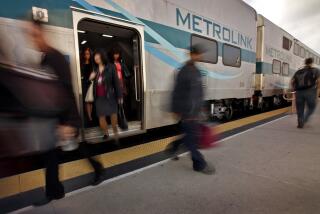Metrolink train in Rialto crash ran red light, inquiry finds
- Share via
Federal investigators said human error or brake problems may have caused a Metrolink train to run a red light before it slammed into a freight train Thursday in Rialto.
The Metrolink crew noticed two lights before the red signal, said Ted Turpin, the National Transportation Safety Board investigator supervising the inquiry. One was flashing yellow and the other solid yellow, which should have alerted the crew that they had to stop so the other train could move off the single line of shared track and onto a side rail.
“They used the brakes but they didn’t stop,” Turpin said.
The Rialto crash, which injured five passengers, marked the second time in less than three months that a Metrolink train had failed to heed a stoplight before hitting another train.
Investigators in the catastrophic Chatsworth crash in September have said the engineer raced past a red light before slamming into an oncoming freight train, killing 25 people and injuring 135 others. The engineer was also text messaging before the impact.
The latest accident prompted Metrolink’s board of directors on Friday to direct staff to explore what would be required to terminate the agency’s contract with the private company that runs the commuter trains.
“If it turns out to be operator error, then it raises serious issues about how [the contractor] is responding to what happened in Chatsworth and the concerns raised by Metrolink,” board member Richard Katz said in an interview.
Thursday’s crash was similar to the Chatsworth collision, except that the commuter train was moving slowly when it hit the Burlington Northern Santa Fe Railway train.
Experts said the crash, coming on the heels of the Chatsworth collision and other deadly Metrolink accidents in recent years, raises safety questions about the popular commuter line.
The Rialto collision, experts noted, was especially troubling because the Metrolink train had two engineers -- a measure enacted after the Chatsworth crash to prevent accidents.
“It’s just intolerable to have so many accidents on one system in a relatively short period of time,” said Barry M. Sweedler, who spent 30 years with the NTSB as an investigator and administrator.
Najmedin Meshkati, a USC engineering professor who has studied rail safety systems, said the accidents point to systemic problems with the agency. “We are dealing with a deep-seated issue that involves the safety culture of the organization,” he said.
Part of the problem, Sweedler said, is that Metrolink contracts out for its engineers, creating a layer of bureaucracy that makes it difficult to hold individuals accountable.
A spokeswoman for Veolia Transportation, whose subsidiary employs the engineers, said Friday evening that officials from the firm were unavailable for comment.
Turpin, the NTSB investigator, said the inquiry would continue several more days and investigative teams would be poring over computer data from the trains, signals and the Metrolink dispatch center.
He said the Metrolink train slammed into the freight train about 120 feet past the red light. Investigators interviewed the Metrolink crew and took statements from the Burlington Northern crew, Turpin said.
“We know pretty much where everything was and what was going on,” he said, adding that it would probably be months before a probable cause could be determined.
A Metrolink spokesman said Friday that all of the agency’s trains would get complete mechanical inspections before beginning service Monday.
Lopez, Connell and Hymon are Times staff writers.
More to Read
Sign up for Essential California
The most important California stories and recommendations in your inbox every morning.
You may occasionally receive promotional content from the Los Angeles Times.











